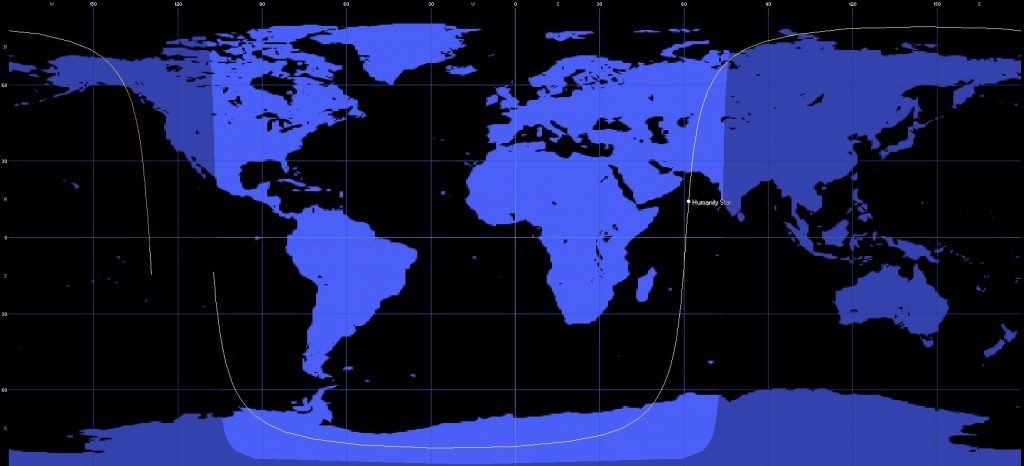Rocket Lab’s Humanity Star Re-Enters after Brief Tenure in Orbit

Rocket Lab’s “Humanity Star” ended a short-lived stint in orbit as a shooting star on Thursday, re-entering Earth’s atmosphere just two months after being placed into orbit as a public awareness project by the U.S./New Zealand launch services provider. Resembling an oversized disco-ball, the small, passive satellite was to provide “a bright symbol and reminder to all on Earth about our fragile place in the universe.”
The Humanity Star was lifted into orbit by Rocket Lab’s Electron launch vehicle on January 21 on its second test flight, dubbed “Still Testing.” A similar satellite had been on the rocket’s inaugural mission in May 2017, but failed to reach orbit when Electron’s flight was terminated due to a misconfigured piece of telemetry equipment on the ground.
Rocket Lab kept quiet about the existence of the Humanity Star and only revealed its presence in orbit days after the successful Still Testing mission, along with news that the launch had carried a previously unannounced kick stage the company plans to employ on future operational missions for additional maneuverability in orbit.

The Humanity Star itself only weighed 10.34 Kilograms and was around one meter in diameter, featuring 76 highly reflective panels on the outside of the geodesic sphere to direct sunlight back to observers on Earth – creating a strobe effect resulting from the satellite’s spinning motion. Rocket Lab’s motivation behind launching the satellite was to place an easily visible object into orbit to “create a shared experience for everyone on the planet” and “encourage everyone to look up, ponder humanity’s place in the universe and think about how we can work together as one species to solve the challenges facing us all.”
Because of its reflective hull, the Humanity Star was easily visible to the naked eye with an apparent brightness around magnitude 4.5 to 7, peaking at a maximum brightness at 1.6 during flashes to match the brightness of the stars around it. A number of observers shared photos and videos of Humanity Star on Social Media, showing the satellite as a fairly dim object between the very brief flashes caused by its reflective surfaces.
https://twitter.com/TheHumanityStar/status/963169527600050176

Some discussion emerged after the satellite’s launch among the astronomical community since reflective objects can interfere with astronomical observations by ground- and space-based observatories. Claims of “vandalism in the skies,” “space garbage,” “pollution of the last great wilderness,” were made by one side of the light pollution debate while others argued that flares by Humanity Star would be few and far in between compared to those of existing satellites including craft with large deployables or reflective areas like the first Iridium generation. Compared to Iridium that operated a spread-out constellation of 66 satellites, Humanity Star was only a single source making infrequent visible passes over any given observation location and its orbital life was limited from the start.
Humanity Star began its journey in an orbit of 290 by 520 Kilometers, inclined 82.9 degrees, and was expected to have a brief lifetime due to its low orbit and relatively high area-to-mass ratio, making it susceptible to drag experienced in the outer layers of Earth’s atmosphere. Rocket Lab had initially estimated the satellite could remain in orbit for around nine months, but its life turned out to be much shorter.

Given its light construction out of one-millimeter thick carbon-fiber composite material, Humanity Star did not pose a threat and was expected to fully burn up on re-entry.
The satellite made its final dive after circling the Earth 951 times, re-entering the atmosphere on March 22nd at 13:15 UTC +/-29 minutes, according to the Joint Space Operations Center that tracks all sizeable objects in orbit and pin-points re-entry events. The large uncertainty in the entry time corresponds to a long stretch of the satellite’s ground-track from Antarctica, across the Indian Ocean, over South and Central Asia and the Arctic Sea, all the way to Alaska and the northern Pacific.
Rocket Lab said on its website that the company has no plans for launching another Humanity Star: “The Humanity Star is designed to be a one-time, short-term experience. The intention was always to draw more people to the night sky, perhaps those who may not otherwise be looking.”
Re-Entry Data
NORAD ID: 43168
Object: Humanity Star
Type: Public Awareness / Space Art
Mass: 10.34kg
Origin: NZ
Inclination: 82.9°
Launch: January 21, 2018 – 01:43 UTC
Launch Vehicle: Electron (Still Testing)
Launch Site: Mahia LC-1, New Zealand
Re-Entry Prediction: March 22, 2018 – 13:15 UTC +/- 29 Minutes
Re-Entry Zone: Unknown
Re-Entry Orbit


